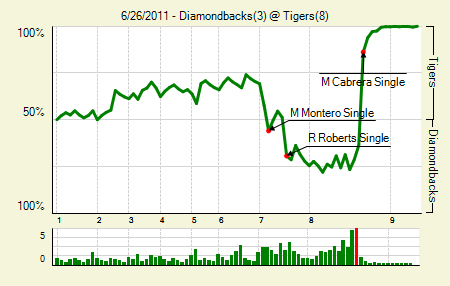The Morning After: Game Recaps for June 26th

Moving the Needle: Miguel Cabera’s two-run single gives the Tigers the lead, +.499 WPA. For the first six innings Jhonny Peralta’s homer stood as the only run. Then the Diamondbacks broke through for two runs, taking the lead. An inning later the Tigers would get it all back. A pair of two-out walks to load the bases is a bad sign and it is made all the worse when Cabrera is the man due up. On a 2-1 pitch he pulled one into left, bringing around two runners and giving his team the lead back. Cabrera’s hit was the first in a string of five straight singles that led to a big inning for the Tigers.
Notables
Jhonny Peralta: 3 for 4, 1 HR. The homer was mentioned before, but Peralta deserves mention for his two-hit, two-RBI day as well.
Joe Saunders: 7 IP, 4 H, 1 R, 1 BB, 8 K. He takes a lot of crap, because 1) he was the most recognizable name in the Dan Haren trade last summer, and 2) he’s not good. He pitched well in this one, however, which gives good occasion to mention that Tyler Skaggs, not Saunders, was the centerpiece of the Haren trade.
Also in this issue: Orioles 7, Reds 5 | Mariners 2, Marlins 1 | Nationals 2, White Sox 1 | Rays 14, Astros 10 | Dodgers 3, Angels 2 | Royals 6, Cubs 3 | Brewers 6, Twins 2 | Yankees 6, Rockies 4 | Phillies 3, A’s 1 | Mets 8, Rangers 5 | Red Sox 4, Pirates 2 | Blue Jays 5, Cardinals – | Padres 4, Braves 1 | Giants 3, Indians 1

